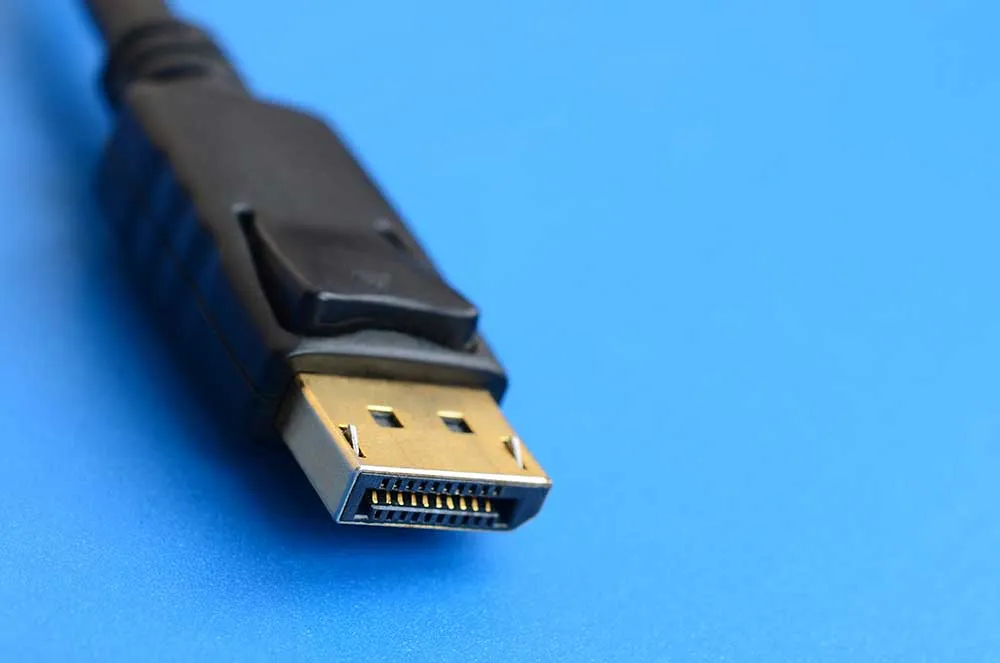The following article explains the main differences of Display Port and Mini Display Port.
https://levvvel.com/displayport-vs-mini-displayport/
What’s the difference between DisplayPort and Mini DisplayPort? Aside from the apparent size, some differences aren’t immediately noticed that you should be on the lookout for when choosing between the two.
DisplayPort vs Mini DisplayPort resolutions

Early versions of Mini DisplayPort (mDP) can display the same maximum resolution as the original size DisplayPort (DP). On the DisplayPort 1.1a version, both can show up to a 2560 x 1600 resolution, and in the 1.2 version, up to a 4096 x 2160 resolution. However, there are no Mini DisplayPort cables that support versions 1.3/1.4/1.4a or 2.0. You’re limited to the amount of bandwidth that the 1.2 version can output with the Mini.
DP 1.0, 1.1, 1.1a
| Specs | DisplayPort | Mini DisplayPort |
|---|---|---|
| Max Link Bandwidth | 10.8 Gbps | 10.8 Gbps |
| Max Payload Bandwidth | 8.64 Gbps | 8.64 Gbps |
| Max Resolution | 3840 x 2160 (4K) / 60 Hz | 3840 x 2160 (4K) / 60 Hz |
DP 1.2/1.2A
| Specs | DisplayPort | Mini DisplayPort |
|---|---|---|
| Max Link Bandwidth | 21.6 Gbps | 21.6 Gbps |
| Max Payload Bandwidth | 17.28 Gbps | 17.28 Gbps |
| Max Resolution | 3840 x 2160 (4K) / 60 Hz \n 3840 x 2160 (4K) / 60 Hz | - |
DP 1.3/1.4/1.4a
| Specs | DisplayPort | Mini DisplayPort |
|---|---|---|
| Max Link Bandwidth | 32.4 Gbps | - |
| Max Payload Bandwidth | 25.92 Gbps | - |
| Max Resolution | 5120 x 2880 / 60 Hz | 7680 x 4320 / 30 Hz |
DP 2.0
| Specs | DisplayPort | Mini DisplayPort |
|---|---|---|
| Max Link Bandwidth | 80 Gbps | - |
| Max Payload Bandwidth | 77.4 Gbps | - |
| Max Resolution | 7680 x 4320 (8K) / 60 Hz / 10 Bit Chroma / HDR | 3840 x 2160 (4K) / 120 Hz / 10 Bit Chroma / HDR |
Why is Mini DisplayPort behind?

How come there aren’t newer versions of Mini DisplayPort cables?
Mini DisplayPort was developed by Apple and was initially revealed in 2008. From the Macbook to the Mac Pro and everything in between, Apple’s entire line of products eventually had their DVI ports replaced with a Mini DisplayPorts.
The Video Electronics Standards Association (VESA) soon reached an agreement with Apple to license the new tech into the DisplayPort standard. Later, companies like HP, Dell, Asus, and Lenovo used the same input in their devices, though mostly limited to laptops and 2-in-1 tablets.
In 2016, Apple began replacing the Mini DisplayPort with USB-C. Meaning the only company that had once used all its devices, including desktops, had abandoned it. Since Mini DisplayPort is primarily used on mobile electronics, the bandwidth that 1.2 offers is more than enough in typical scenarios such as hooking it up to a single large monitor, television, or projector.
There is no actual consumer demand for higher versions with more bandwidth, so companies never bothered to invest their resources in further developing it.
Should I use DisplayPort or Mini DisplayPort?
Single monitor setup
It all depends on what monitor you’re working with and what kind of setup you want to be looking at. If you’ve just got a single monitor and it only has a Mini DisplayPort, then go with the Mini. If you got a regular size DisplayPort, then go with that one. If you’ve got both options, go for the normal size because you will be able to use higher resolutions with the newer versions.
Go for the larger and newer DisplayPort version whenever possible. There’s not much of a price difference between the versions. All DisplayPort versions are backward compatible, so there is no need to worry there.
Multi-monitor setup
The bandwidth and resolution that DisplayPort can output are usually more than good enough if you’re using a single monitor setup. For most users, that’s going to be true since today’s monitor typically sport a 2560 x 1440 or 1920 x 1080 resolution. But if you’re trying to set up a multi-monitor setup, you can quickly run out of bandwidth if you’re not careful with the number of monitors and their resolution size.
For multiple monitors, you’ve got a few options:
If your graphics card has multiple DisplayPort outputs, you can have a separate cable for each monitor that you have.